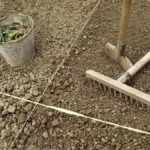Starting a vegetable garden can be fun and an inexpensive way to bring healthy food to your kitchen table. But it can be overwhelming if you don’t know where to start.
The secret to getting started with vegetable gardening is to take a little time to make a plan. Take a look at your yard or patio or front stoop; think about what you’d like to grow; talk to the staff at a local nursery or garden center; talk to friends and neighbors with experience, and visit Harvest to Table and other websites dedicated to growing healthy food.
Don’t plan to do too much at first, but plan to have fun. Vegetable gardening is something you can do as a family or a great way to spend time alone enjoying nature.
Good Products for Raised Bed Growing at Amazon:
- Galvanized Raised Bed 8×3
- Cedar Raised Bed 4×8
- Elevated Cedar Planter 4×2
- Walk-In Greenhouse Tunnel 15x7x7
- Row Cover for Freeze Protection 10×30
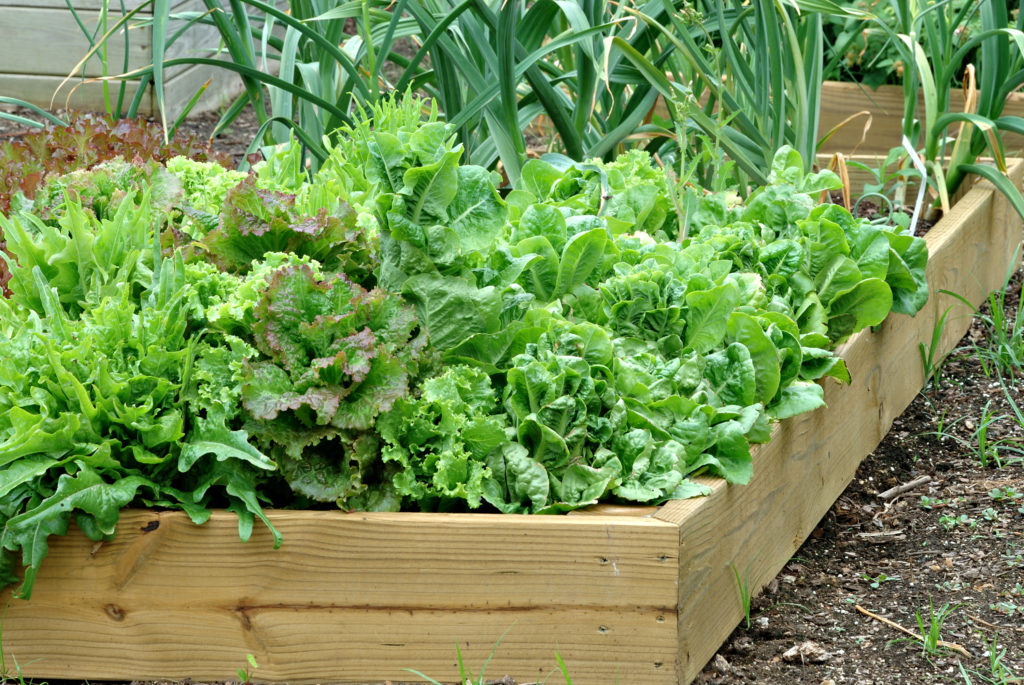
Six ways to make a successful vegetable garden
- Choose a sunny site for your garden. Make it convenient—close to a water source and your kitchen; you’ll want to visit every day.
- Prepare and feed your soil. Add aged compost and organic amendments across your planting beds before you plant and lightly rake or turn the compost under. This will ensure healthy plant growth.
- Match the plants you grow to your region, climate, and site. Sow and plant regionally adapted seeds and seedlings in the right season. Choose varieties that are pest and disease resistant. You will find seeds and seedlings adapted to your region at a nearby nursery or garden center or online.
- Keep plants naturally healthy with proper spacing, watering, feeding, and mulching.
- Use safe and natural pest, disease, and weed controls.
- Harvest your crops at the peak of maturity or sooner for the best flavor.
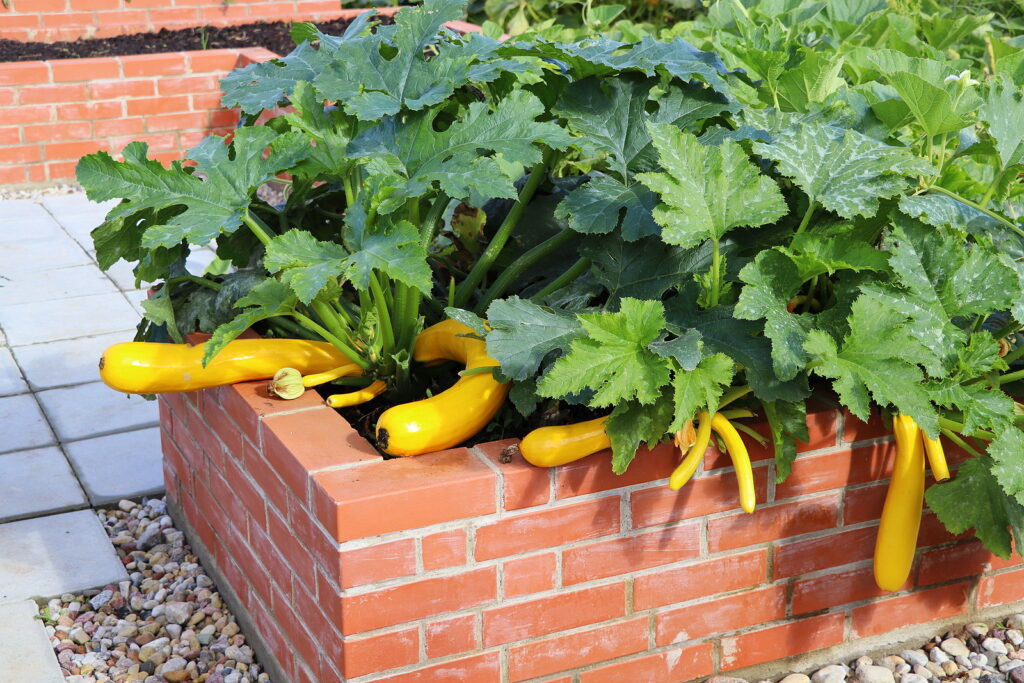
What does a vegetable garden look like?
Here are a few vegetable garden ideas you can plant:
- A porch pot planted with radishes and lettuce.
- A window box planted with a half dozen different kinds of herbs.
- A half wine barrel planted with a tomato, a cucumber, and a zucchini.
- A narrow flowerbed border planted with radishes, leaf lettuce, carrots, and beets.
- Staked tomatoes or snap beans are planted on poles at the back of a flowerbed.
- A narrow planting bed in front of a wall or fence planted with tomatoes, pole beans, cucumbers, or cantaloupes trained up a trellis.
- A square 3-by-3-foot (.9 m) planting bed in the backyard with salad crops including leaf lettuce, spinach, green onions, and radishes.
- A 3-by-6-foot (.9 x 1.8 m) rectangular planting bed with tomatoes, peppers, and onions—growing your own fresh salsa.
- The same 3-by-6-foot bed grows beets, carrots, parsnips, turnips, green onions, cabbage, and Brussels sprouts for autumn soups and stir-fries.
- A 4-by-8-foot (1.2 x 2.4 m) planting bed growing potatoes, cucumbers, tomatoes, peppers, and melons—a summer picnic garden followed by cabbage, Brussels sprouts, parsnips, carrots, and turnips for winter stews.
Your vegetable garden can look like whatever you want it to look like and it can grow whatever you want to eat. Look at the ingredients of your favorite vegetable recipes then grow what you need.
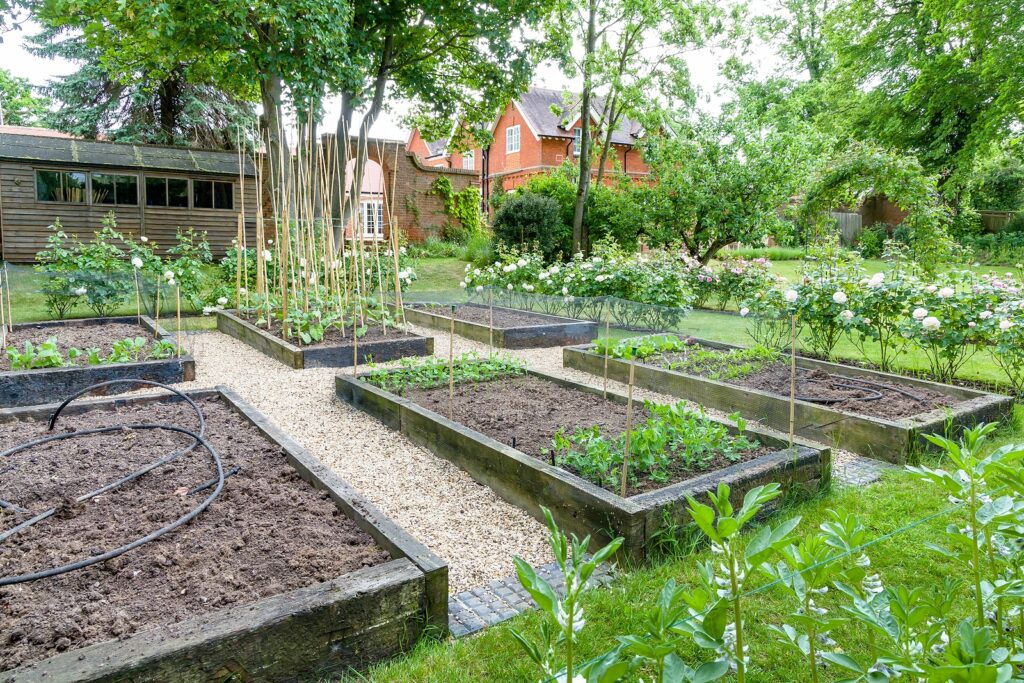
What every vegetable garden needs
Here are the basic elements needed by every vegetable garden:
Sunlight is a must
Vegetables need a lot of sunlight to grow well. The most productive vegetable garden must receive no less than six full hours of sunlight each day; eight hours is best. Your vegetable garden should not fall in the shadows of trees, shrubs, walls, fences, or buildings. Take some time to observe the sun and shade patterns in your yard throughout a summer day. If shade is cast on your site for more than two hours a day, pick another spot or plan to grow only shade-tolerant crops, such as salad greens, beets, and cabbages. If the garden is partially shady it is unlikely that you can grow tomatoes and beans.
If trees grow near the garden, plant at least 10 feet from the outer edge of the branches. Tree roots can rob a vegetable garden of water and nutrients. Draw a sun and shade map over the course of the day. Where do shadows fall? Vegetables to best when they get morning sun; that is a minimum requirement for success.
A yield of delicious vegetables is greatly beholden to exposure. Site your garden in an “early” spot–a plot facing or sloping a little to the south or east that seems to catch sunshine early and hold it late–eight hours of sunlight each day is optimal. Make a “sun map” of your yard tracking the sun across the property over the course of a day. Avoid situating your vegetable garden in the shadows of buildings, trees, and fences. Choose a spot that is out of the direct path of chilling north and northeast winds. A building, a fence, or a hedge to the north of your plot can protect your garden from chilling winds. Even low-growing shrubs or young evergreens can protect vulnerable tender vegetables.
A few tips: north, south, east, west—around the garden
- A south or southeastern exposure is warmest and will produce earlier crops.
- Warm-season crops planted near the south side of a building will benefit from heat radiated from walls.
- A north exposure favors cool-weather crops, leafy and root crops—but you still need some sun. Don’t plant closer than 10 feet on the north side of a building or fence; that space will likely be in the shade all day.
- Western exposures are warmer than Eastern exposures. Even so, western exposures are often in shade until at least noon each day.
- The east or south side of the garden is best for low-growing plants; they won’t cast much shadow on other plants.
- Place tall plants on the north side of the garden where they will cast fewer shadows over the course of the day. Tall plants on the west side of the garden will cast shadows across the garden at the end of the day.
Full sun gardens offer vegetables the best growing conditions. A full-sun site warms quickly in spring and will produce through the season. Don’t worry about a full-sun site being too hot or too dry. You will be adding plenty of aged compost and planting mix to your garden; these ingredients will hold soil moisture while feeding plants.
A shady site is not optimal, but it does not rule out growing vegetables. A shady site will be cooler than a sunny site and the growing season may be shorter. If you can’t reduce shade by pruning overhanging trees or moving shadow-casting obstacles then grow crops that don’t mind some shade such as lettuce, spinach, and other salad greens, and also potatoes and sunchokes.
Let’s review garden exposures:
- South-facing gardens are ideal for sun-loving crops; the garden will be warm and bright.
- West-facing gardens will get sunshine for most of the day except for early in the morning.
- North-facing gardens are likely to be shady and cool most of the day; north-facing gardens are not optimal for sun-loving crops such as tomatoes and peppers but may be a good spot to grow lettuce and salad greens.
- East-facing gardens will get morning sun allowing plants to dry out from evening dews; plants get off to a better start when bathed in morning sunshine; but east-facing gardens may fall into afternoon shadows.
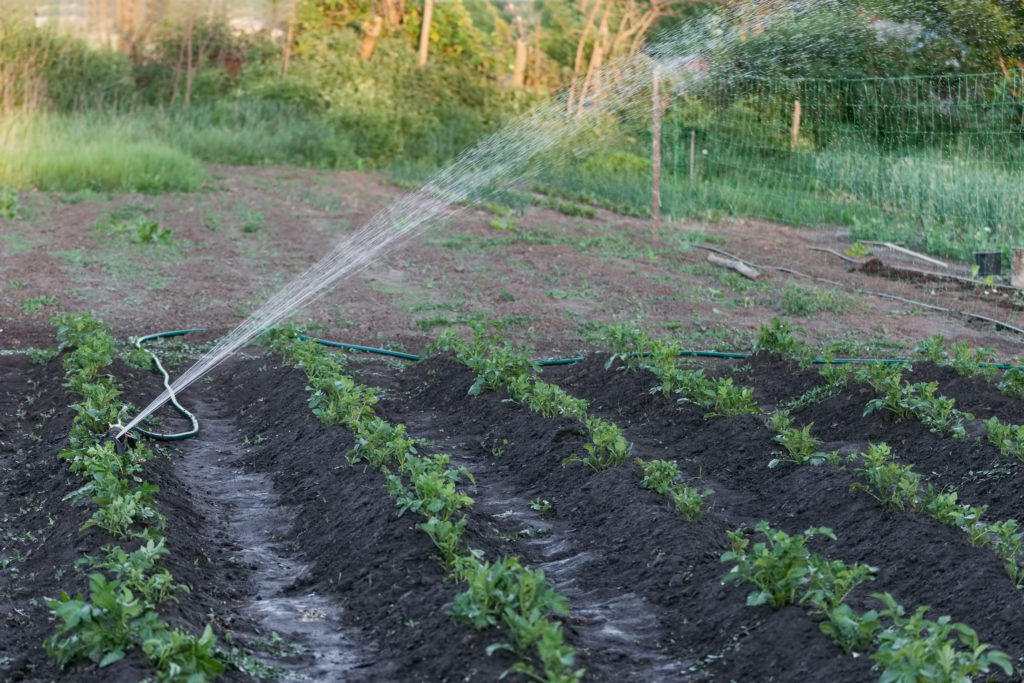
Water nearby
Choose a site within easy reach of an adequate supply of water; no further away than the reach of a light hose will be a tremendous help in times of protracted drought.
Your garden needs to be near an ample supply of water. When possible, locate the garden near a hose bib—you won’t want to lug around a long, heavy hose if you don’t have to. A convenient source of water will make your mid-summer watering tasks much easier.
Vegetables are made mostly of water. Water is essential for seed germination, photosynthesis, and the delivery of nutrients to plant cells. When a plant doesn’t get enough water it will slow or stop growing. A vegetable stressed by lack of water will drop its blossoms and leaves; its fruits will lose flavor; it will be more vulnerable to pests and diseases; it ultimately could die.
Make your garden water friendly by adding lots of aged compost and organic matter to your planting beds; plant in wide rows, and use compost mulches in hot weather.
Good drainage
While water nearby is important, don’t locate your garden where water sits on the ground for more than an hour after a hard rain or after irrigation. Vegetables don’t like wet feet—that is soggy roots. Few crops can absorb nutrients if their roots stay wet, and wet roots may rot. If a wet spot is all you have to work with, raise the garden up; grow on a mounded or raised bed. Always a good policy is to add plenty of aged compost to planting beds no matter where they are located. Aged compost feeds the soil, feeds plants, and ensures good drainage.
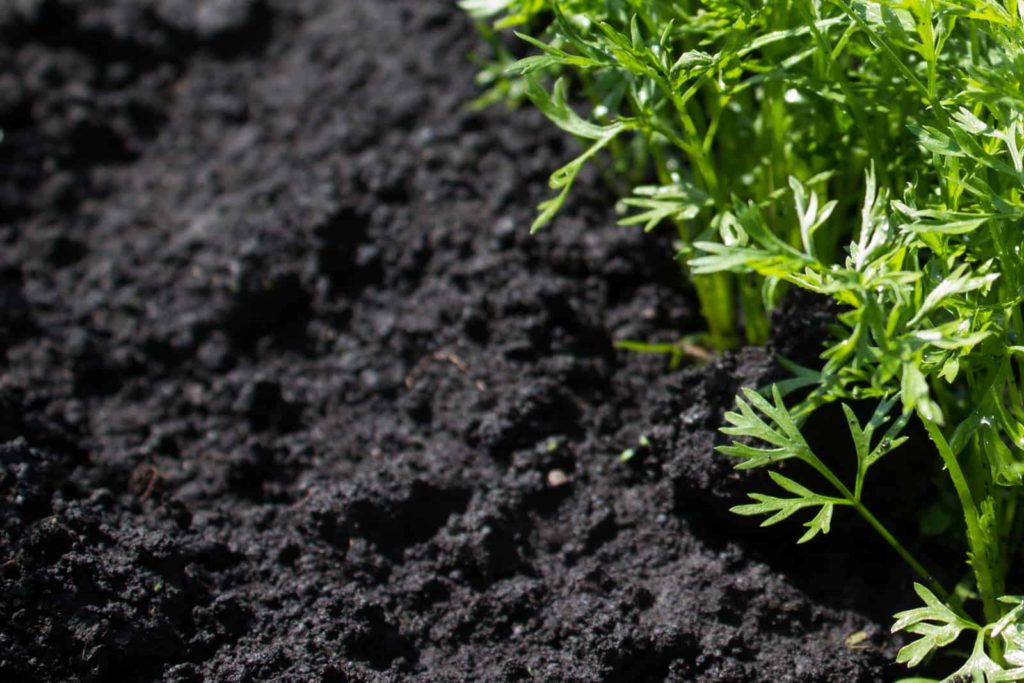
Good soil
You may not have a choice about how good your soil is to start with, but with a little work, you can improve almost any soil by adding aged compost or commercial organic planting mix to planting beds and then lightly forking or turning the compost under.
As a rule poor soil almost always can be improved and good soil can be made better. Choose a planting site free of rocks and stones and one that is easily worked with a garden fork or spade. Choose a site that is level, but if your garden is on a slope you can terrace or run your crop rows across the slope and keep the soil from washing away. Loosen the soil where you plan to plant using a garden fork and remove grass, weeds, and stones. Next, lay aged compost across the planting bed site; sheet composting is the addition of an inch or two or more of aged compost spread across the bed. Aged compost will work its way into your native soil via rain and irrigation and within a year or so, you will have a rich productive planting area—even if the site seemed unproductive when you first arrived.
Almost any site that has been in cultivation for a year or two previous to your starting up the vegetable garden will have an advantage. The soil will have already been turned and aerated and worked to some depth by the roots of plants that have come before.
Close to the kitchen
Select a spot near at hand, easy and quick to get to. Choose, as you can a spot, close to the kitchen. A garden close by will capture your spare moments for tending and for watching the garden. And a garden close by will be greatly appreciated once you have made a dozen time-wasting trips for forgotten seeds or tools, or gotten your feet soaking wet by going out through the dew-drenched grass
Locate your garden as close to the house and as close to the kitchen as possible. Put your garden where it’s easy to visit every day. You will spend more time in your garden if it is nearby and easy to reach. A kitchen garden should be as close to the kitchen as possible. There’s no substitute for salad greens and tomatoes picked moments before they are served. Summer corn is tastiest when dropped in a kettle of boiling water minutes after it has been picked. And if you have no room for a garden in the ground, you can grow almost all vegetables and herbs in pots, barrels, and boxes on the patio, porch, or front steps—very close to the kitchen.

Out of the wind and away from low spots
Choose a site that is protected from the wind–cold winds in the spring and drying winds in the summer. Avoid low-lying spots where cold air or frost can settle.
Even a gentle prevailing wind can draw moisture from vegetable leaves resulting in windburn and even the death of plants. Strong winds can uproot tender seedlings and topple crops that are top-heavy when ripe. If the wind is constant where you live, consider permanent or temporary windbreaks. A windbreak can be a building, a fence,d or a hedge, but it can also be a tall dense crop such as corn or sunchokes planted on the windward side of the garden.
While wind can be destructive, air circulation is important. Don’t plant vegetables in low-lying spots where cold air and frost can be trapped or settled. Cold air naturally drains into low spots. Low-lying areas or areas shielded by shrubs, trees, and fences may inhibit air circulation and become a “frost pocket.” Moderate air circulation is best.
Moderate air circulation and adequate plant spacing will help foliage when the dew settles on the garden reducing the possibility and severity of fungal and bacterial diseases.
Sites to avoid if you can
- Avoid low spots in the garden where water puddles or runs off after rain. Low spots can also trap cold air and frost.
- Avoid steep slopes; water and soil can run off steep slopes unless they are well-terraced.
- Avoid shady spots and areas where the roots of trees or large shrubs will compete with your vegetables for water and nutrients.
- Avoid compacted soil—areas that have been used for footpaths or drives.
- Avoid windy spots—steady winds and breezes will sap plants of moisture.
- Avoid sites next to roads where fumes and street runoff can pollute the garden.
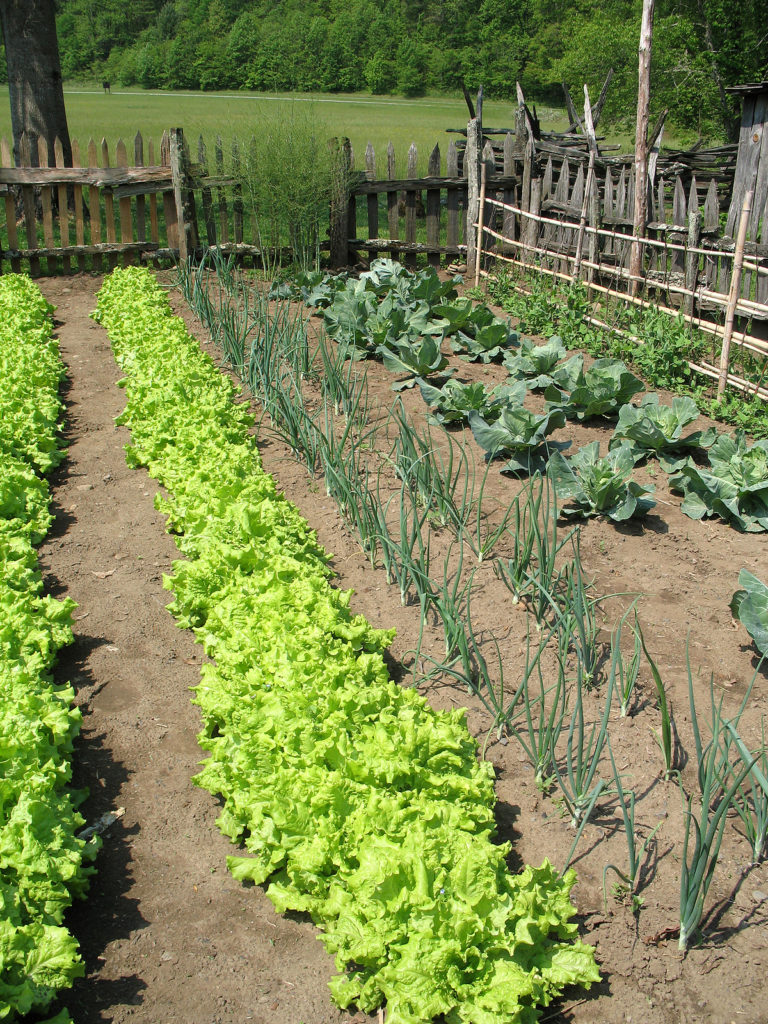
Vegetable garden size
A vegetable garden can be any size and shape. In one season, a garden as small as just 4-by-4 feet can produce a head of cabbage, a head of broccoli, a head of cauliflower, four heads of romaine lettuce, four heads of leaf lettuce, nine bunches of spinach, nine bunches of Swiss chard, sixteen baby carrots, sixteen full-size carrots, sixteen beets, and thirty-two radishes. All of that during just the cool time of the year. The same garden bed can be planted with tomatoes, beans, peppers, and cucumbers when summer comes. Just think what you could grow in a planting bed twice that size if you planted in both the cool and warm times of the year.
When you are deciding how big your vegetable garden should be—think first about the time you have for gardening. How many minutes or hours do you have in a week to care for your garden? Be conservative. Don’t over-commit. Start small. With experience, your garden can grow and grow. A small garden well maintained is better than a large garden that will leave you tired or discouraged by midsummer.
How large should your vegetable garden be?
The answer to this question will come by answering a few other questions:
- How much time can you spend in the garden? You don’t want a garden larger than you have time for.
- What vegetables do you and your family like? Keep a family food diary for 2 to 4 weeks. Record all of the vegetables, fruits, and herbs you eat fresh—or would like to eat fresh.
- Would you like to store or preserve vegetables for the off-season, for winter? If you plan to freeze, dry, or can some of your harvests, you will want to grow more.
- How much space do you have? Use graph paper to map out your potential garden. Draw in beds and paths—how many square feet do you have to work with?
- Plan a small garden first. To get started grow a limited variety of vegetables. Start with the vegetables, herbs, and small fruits you love most. Grow the size of your garden as you gain experience.
- During the first year, keep a notebook; record what worked and what didn’t work. What was fun about the garden and what you did not like? What crops grew well and which ones were difficult? Write suggestions to yourself for next season.
- Your garden will improve from one year to the next and your enjoyment will grow.
Garden size checklist
- Existing trees, shrubs, walks, and buildings may determine, in part, where you can plant and how much vegetable growing space you will have.
- Look at your site throughout the day and map where and when the garden is in the sun or shade.
- Pick a spot close to a water source and close to the house. It also should be close to the tool shed and a site for a compost pile.
- Choose a spot for your planting beds that is easy to access; you’ll want planting beds that are easy to work with an outstretched arm. If your planting bed is accessible from only one side, make sure you can reach comfortably to the back of the bed without stepping into it.
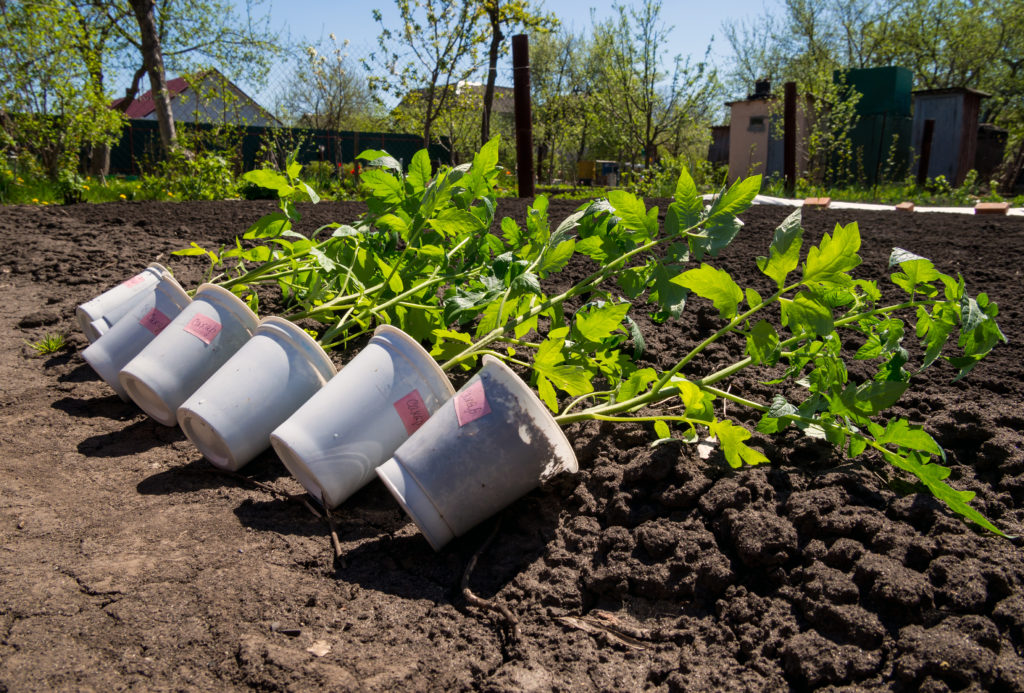
More about garden soil
The chances that you will find a spot of ideal garden soil ready for use are slim. But just about all soils can be brought up to a very high degree of productiveness –especially such small areas as home vegetable gardens require. Even spots of nearly pure sand or heavy muck can often be amended to yield very satisfying harvests. So don’t be discouraged by poor or run-down soil, rather resolve to make it rich.
The ideal garden soil is a “rich, sandy loam.” And the fact cannot be overemphasized that such soils usually are made, not found. Let us analyze that description a bit, for right here we come to the first of the four all-important factors of gardening–food. (The others are cultivation, moisture, and temperature.)
“Rich” in the gardener’s vocabulary means full of plant food; more than that–and this is a point of vital importance–it means full of plant food ready to be used at once, all prepared and spread out on the garden table, or rather in it, where growing things can at once make use of it; or what we term, in one word, ‘”available” plant food.
Let’s define each word in the description “rich, sandy loam:”
Rich soil is a soil rich in nutrients. Soil is made rich, or kept rich, in two ways; first, by cultivation, which helps to change the raw plant food stored in the soil into available forms; and second, by composting and manuring or adding plant food to the soil from outside sources.
“Sandy”–as used above–means soil containing enough particles of sand so that water passes through it without leaving it pasty and sticky a few days after rain or irrigation. A sandy loam soil is often called “light” which means that a handful, under ordinary conditions, will crumble and fall apart readily after being pressed in the hand. It is not necessary that the soil be sandy in appearance, but it should be friable. Friable describes soil texture that is loose and crumbly and easily penetrated by roots and water.
“Loam” is rich, friable soil. Loam is the soil in which the sand and clay are in proper proportions, so that neither greatly predominates. Loam is usually dark in color, from cultivation and enrichment. A loamy soil, even to the untrained eye, just naturally looks as if it would grow things.
Besides adding well-aged compost and manure to transform poor soil into rich loam, you can also grow cover crops of green manure in the off-season to help enrich your soil. Green manures are quick-growing crops such as buckwheat, clover, rye, or other grain or legume crops that are cut down and turned into the soil where they decompose and provide nutrients and humus.
The addition of compost, manures, and green manures twice a year for just two years can turn soil that has too much sand or too much clay into good garden soil.
A vegetable garden site must be well drained. Dig down eight or twelve inches after you have picked a spot for your garden, and examine the subsoil. Second strata soil–the soil below the topsoil–is usually of different texture and color from the surface soil, and it is commonly harder. If you find a sandy or gravelly subsoil, no matter how poor it looks, you have chosen a good spot. But if the sub-soil is thick, heavy clay, especially blue clay, you will have either to drain it, amend it heavily with compost, manure, and green manure, or be content with a garden that is slow to warm in the spring and will likely be reluctant to yield heavy crops in summer.
One suggestion, if the spot you choose for your garden has poor soil or is poorly drained, plant a crop of potatoes or sweet corn on this spot the first year or two. These crops are not deeply rooted and feed in shallow soil. At the same time, their roots will begin the work of breaking up heavy, clay soil.
How to improve your garden site
- Prune or remove trees that shade the site.
- Use raised beds to rise above rocky or compacted soil and improve drainage.
- Terrace a steep slope to make it useable for a garden.
- Build a strong fence or plant a hedge to block constant breezes or strong winds.
- Plant vegetables in containers where the only sunny spot you have is a deck, patio, or paved spot.
- A garden that is rectangular or square is easily worked, particularly if the garden is open at least on two ends. Your garden need not be deep–no deeper than your reach. A home vegetable garden is best tended from the edges, meaning it is best to avoid walking on your growing beds and compacting the soil.
- If you have room for two plots, do it, or plan to add a second plot in a season or two. Two plots will allow you to take advantage of the practice of rotation, alternating grass, potatoes, or corn (shallow feeders) with deeper-feeding vegetables. Crops and crop families are best shifted to different plots every year or two. Of course, you can practice crop rotation to some extent within the limits of even a small vegetable garden, but it can be more effective and productive, if possible, to rotate the entire garden patch.
Seven steps to start a vegetable garden
1. Visit nearby vegetable gardens and see what your friends and neighbors are growing. Visit a community garden and see what vegetable gardeners in your neighborhood and town are growing. You will see vegetables and small fruits that are easy to grow, and probably get some great ideas on how to plant a garden. This article will be helpful: Vegetable Garden Planning.
2. Visit a nearby garden center or nursery. See what kinds of vegetable seedlings and seeds are available. Seed packets and plant labels usually have good growing information—the number of days the vegetable requires to reach harvest and how to plant it. Ask questions; garden center and nursery staffers are happy to answer questions and can recommend specific crops for your area.
3. Make a list of the vegetables and small fruits that you and your family or the people in your household like to eat. Which vegetables are your favorites? These are the crops you will want to grow first. Here are ten easy-to-grow vegetables (click on the crop you want to grow): beans, beets, broccoli, cabbage, carrots, leaf lettuce, onions, Swiss chard, radishes, spinach, and tomatoes.
4. Make a sketch or diagram of the area where you want to grow your vegetables. Graph paper is an easy way to diagram the planting bed where you want to grow vegetables this season or map a larger area where you’d like to garden over a period of time. Pencil in the different crops you want to grow. Note the hours of sun that will shine on your garden and the time of day when the garden is in shade. Note how large plants will be at mature size. This article will be helpful Vegetable Garden Calendar and Map Keeping.
5. Share your plan with a friend who gardens—their experience will be very helpful. But, in the end, this is your plan and your garden. Grow a garden that pleases you—this is key!
6. Putting a shovel or trowel in the soil is your first step to actually growing vegetables. A local garden center or nursery will have everything you need to grow vegetables: shovel, rake, hose, soil amendments, seeds, and vegetable seedlings. For your first vegetable garden, don’t buy more than you can get planted in a day or two. This article will be helpful: No Dig and Light Dig Vegetable Garden Preparation.
7. Once your seeds or seedlings are in the ground, water will be very important. Water just enough to keep the roots of your vegetables moist—this may mean watering every day in hot weather or a couple of times a week in warm weather. Follow the advice on seed packets and plant labels, ask neighbors and friends for advice, and visit Harvest to Table often for growing and harvest tips. These articles will be helpful: Vegetable Watering Tips and Vegetable Harvest Times.
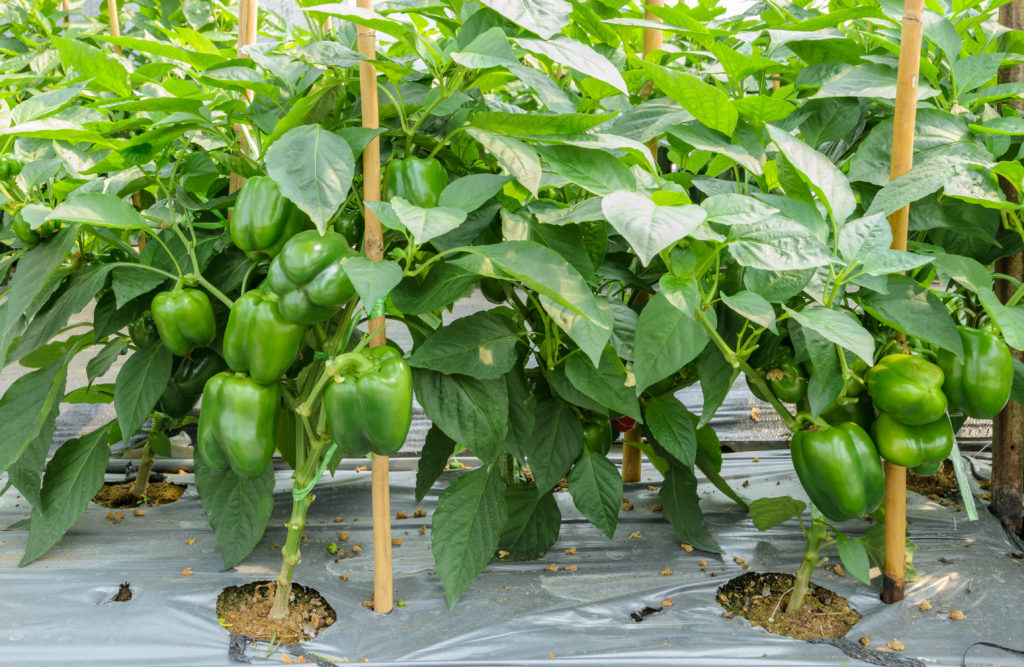
Vegetable crops for beginning gardeners
Beginning vegetable gardeners can be easily intimidated by the scores and scores of vegetable seed varieties available from even the smallest seed retailer. There are hundreds of vegetable varieties available in garden centers and online each year. What to plant?
Taste, quality, speed to harvest, total yield, ease of harvest, plant habit, disease, and pest resistance are desirable traits for success in the home garden. Adaptability to a range of micro-climates and wide availability are important as well.
There is no substitute for growing a vegetable crop yourself to determine if it is right for you and your family, but you can find help. All-America Selections is an independent, nonprofit organization that has conducted growing trials of new vegetable varieties almost every year since 1949.
All-America Selections asks selected growers at 40 geographically divergent test gardens across the United States and Canada to compare new varieties alongside two or three similar varieties currently on the market. The best garden performers are named AAS Winners.
Most AAS trial winners are hybrid plants meaning you will have to buy new seed each year to grow the same crop. The alternative to hybrid varieties are open-pollinated varieties; seeds from open-pollinated plants can be collected from your own garden and replanted the following year—you won’t have to buy new seed each year. Almost all heirloom vegetable varieties are open-pollinated.
All-America Selection winners are good bets for beginning gardeners (and many seasoned experts swear by them). They will grow in just about any region of North America, yield well, and taste good. Until experience recommends crop varieties, AAS crops will serve you well.
AAS Vegetable Winners Since 1949:
- Basil: Magical Michael, Sweet Dani (lemon), Thai Siam Queen.
- Beans: Derby (snap), Fordhook 242 (bush lima bean), Goldencrop Wax (bush yellow bean), Kentucky Blue (pole snap).
- Beets: Ruby Queen.
- Broccoli: Green Comet, Premium Crop.
- Brussels sprouts: Jade Cross.
- Cabbage: Dynamo (green), Stonehead (early, less than 100 days from planting to harvest), Ruby Ball Hybrid (red), Savoy Ace, Savoy Express, Savoy King.
- Cantaloupe: Samson, Bush Star.
- Carrot: Gold Pak, Purple Haze, Thumbelina.
- Cauliflower: Snow King, Snow Crown.
- Cilantro: Delfino.
- Corn: Honey ‘N Pearl, Honey Select, How Sweet It Is, Indian Summer, Early Xtra Sweet.
- Cucumber: Diva, Fanfare, Liberty Hybrid, Salad Bush, Saladin, Sweet Success.
- Dill: Fernleaf
- Eggplant: Fairy Tale, Gretel
- Kohlrabi: Grand Duke.
- Lettuce: Buttercrunch (butterhead type), Great Lakes (crisphead type), Salad Bowl, and Red Sails (both loose-leaf).
- Melon: Amy, Angel, Lambkin, Melemon.
- Okra: Blondy, Burgundy, Cajun Delight.
- Onion: Super Star.
- Peas: Freezonian, Mr. Big (green garden types), Sugar Ann and Sugar Snap (both edible pod snap peas).
- Peppers: Bell Boy, Blushing Beauty, Cajun Belle, Carmen, Cayennetta, Early Pimento, Giant Marconi, Gypsy, Hole Mole, Mariachi, MaxiBelle, Orange Blaze, Sweet Banana, Super Chili.
- Pumpkin: Autumn Gold, Baby Bear, Hijinks, Orange Smoothie, Sorcerer, Spirit, Autumn Gold, Wee-B-Little.
- Radish: Cherry Belle, Champion.
- Spinach: Melody Hybrid, America.
- Summer Squash: Cream of the Crop, Early Prolific Straightneck, Eight Ball, Papya Pear, Peter Pan Hybrid, Sunburst, Scallopini, Tivoli.
- Winter Squash: Bonbon, Honey Bear, Bush Delicata, Jersey Golden Acorn, Sunshine, Sweet Mama, Table King (four acorn types), Waltham, and Early Butternut (both butternut types).
- Swiss Chard: Bright Lights.
- Tomato: Big Beef, Celebrity, Husky Gold, Jasper, Jolly, Juliet, Terenzo. Sugary.
- Turnip: Purple Top White Globe.
- Watermelon: Faerie, Golden Crown, Harvest Moon, New Queen, Shiny Boy, Sweet Beauty, Yellow Baby.
- Zucchini: Aristocrat, Greyzini, Gold Rush, Burpee Fordhook.
Selecting vegetables for your garden
What vegetables should you grow in your garden?
There are three basic guidelines to follow: Plant the vegetables that you and your family like to eat; plant vegetables that are suited to your region, to the time of year, and to the space and time you can devote to gardening; decide if you are going to eat what you grow fresh, or freeze, store, dry, or can.
Here are some quick lists to get you started:
Best crops for a short season: arugula, beans (bush), beet, cabbage (early cabbage and Chinese, carrots, lettuce, mustard greens, onions (from sets), peas, radishes, scallions, and turnips.
Best crops for a long season: artichokes, asparagus, beans (pole, dry, lima, and soy), celery, eggplant, kale, leeks, onions, peppers, potatoes, rhubarb, tomatoes.
Best crops for cool weather: arugula, asparagus, broad and fava beans, beets, broccoli, cabbage (including Chinese), carrots, cauliflower, celery, chicory, collards, endive, kale, kohlrabi, leeks, lettuce, mustard greens, onions, parsnips, peas, potatoes, radicchio, radishes, rhubarb, rutabagas, Swiss chard, shallots, spinach, turnips.
Best crops for warm weather: globe artichokes, beans (except fava), corn, cowpeas (blackeyed peas), cucumbers, eggplant, lima beans, melons, okra, peppers, pumpkins, soybeans, New Zealand spinach, squash (summer and winter), sweet potatoes, tomatoes.
Crops requiring the least space: beans (bush and pole), beets, carrots, Chinese cabbage, eggplant, leeks, lettuce, mustard greens, onions, parsnips, peppers, radishes, sunflowers, Swiss chard, tomatoes, turnips.
Crops requiring the most space: artichoke (globe), broccoli, cauliflower, corn, cucumbers, melons, peas, potatoes, sweet potatoes, winter squash.
Most productive crops for time invested: beans (bush), broccoli, onions, beets, carrots, Swiss chard, Chinese cabbage, New Zealand spinach, mustard greens, lettuce, turnips, cabbage, radishes, spinach, and summer squash.
Easiest crops to grow: Tomatoes, beans (green and dry), beets, lettuce, potatoes, radishes, most root crops, salad greens, squash (summer and winter), sunflowers, Swiss chard.
Challenging crops to grow: cantaloupe, cauliflower, celery, Chinese cabbage, corn, leeks, parsnips, peas, watermelon.
Related articles:
Small Vegetable Garden Space Savers
Garden Planning Books at Amazon:
- Vegetable Garden Almanac & Planner
- Kitchen Garden Grower’s Guide Vegetable Encyclopedia
- Vegetable Garden Grower’s Guide
- Tomato Grower’s Answer Book














